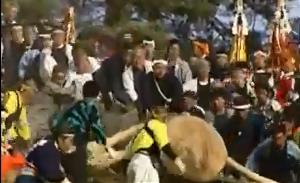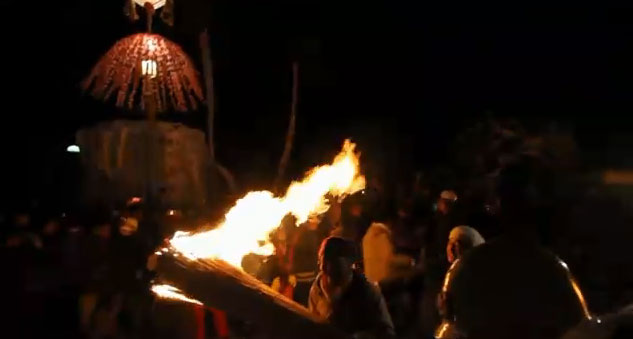
However, upon looking closer, the reasoning behind the deadly log rides that have become fodder for Youtube videos and Western head-shaking is not only fascinating, but deeply rooted in traditional Japanese culture.
What you have just witnessed is one part of one of Japan’s largest religious festivals. Onbashira occurs every six years (every seven according to the Japanese way of counting things)in the Lake Suwa region near Nagano, Japan. Comprised of two parts, the traditional Shinto festival attracts as many as two million visitors to the region, and it has existed for nearly 1200 years. Onbashira (“the honored pillars”) are large tree trunks that sit in the four corners of the four shrine complexes of Suwa Taisha, the Suwa Grand Shrine.
‘Coming out of the mountains’
The source of the onbashira are 200 year old Japanese fir trees, sixteen of which are carefully selected for harvest come time for the festival. Their harvest and the laborious process of transporting them to Suwa Taisha comprise the first half of the festival, called Yamadashi, literally ‘coming out of the mountains’.
Trees who are to become onbashira are felled using axes and adzes specifically made for the ceremony. Once the logs are felled, and after various Shinto ceremonies are performed, it is time to move the 12 ton hunks of wood down the mountain. This is done by hand, using ropes, and is performed by specially selected groups of men. The traditional route down the mountain includes steep slopes. Ki-otoshi, meaning “tree drops”, occur at these point. Men ride the logs down the slopes in order to prove their courage. As might be expected, injuries and deaths are not all that uncommon during the wild slides down the steep slopes. But not to worry; dying during ki-otoshi is considered an honorable death.
The onbashira come home
Once the onbashira are man-handled down the mountain side, they (and the men who pulled/rode them) are allowed to rest a month, during which time the festival continues. Once the rest is over, the second phase of the Onbashira festival, Sabotiki, begins. As you might have guessed by now, it features lots of physical labor and the threat of bodily harm. The huge logs are carried through the streets of the city to the Suwa Taisha complex, where they are raised by hand at the four corners of each shrine. Young men intent on showing their bravery ride the logs as they are erected. Men have died during this ceremony by falling off the top of the logs, or by being crushed if the ropes slip and the log topples over. However, if all goes well and the onbashira are seated correctly, there they will remain for the next seven years, until it comes time to replace them.
Sources:
Japan Atlas — Onbashira Festival
The Telegraph — Two die in Japan’s notorious tree-sliding festival
CNN Travel — Onbashira-sai festival: The log surfers of Lake Sawa




Dear Japan Powered,
My name is Hugh Esling. I blog on world events. I just posted one up on the Onbashira Festival. If you like it and can use it, please feel free to share, link, or
tweet it.
http://www.hughesling.com/blog/log-riding-japans-onbashira-festival
Regards,
Hugh Esling
Nice article! I tweeted your link.
Thanks for the tweet, Chris.
Hugh Esling